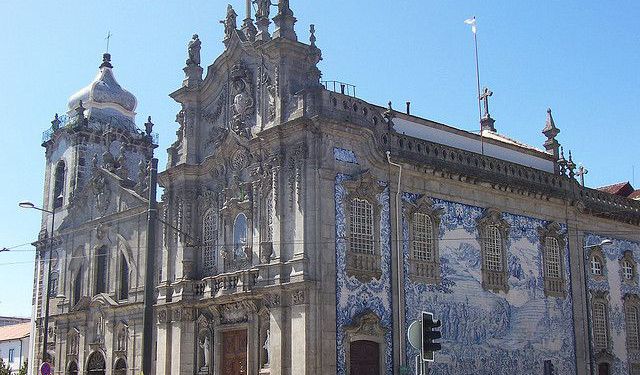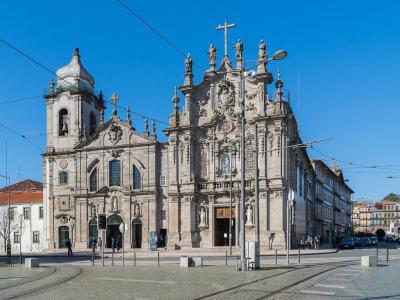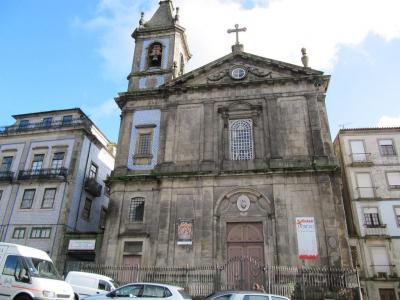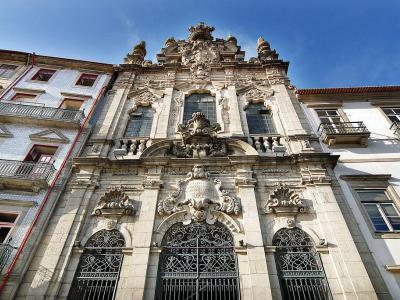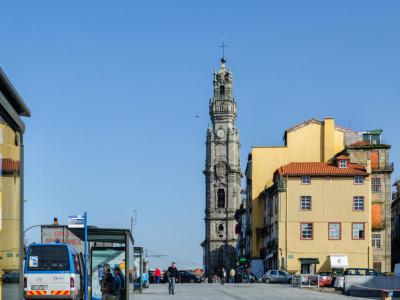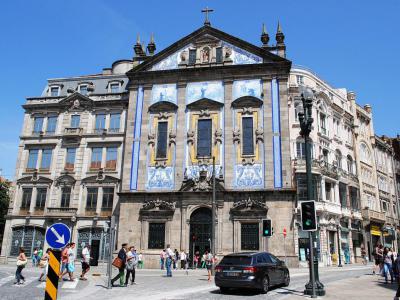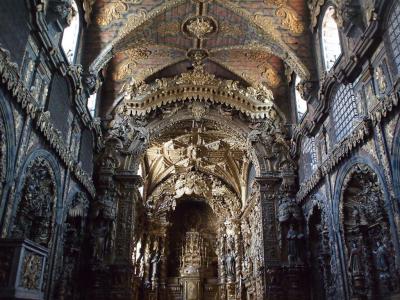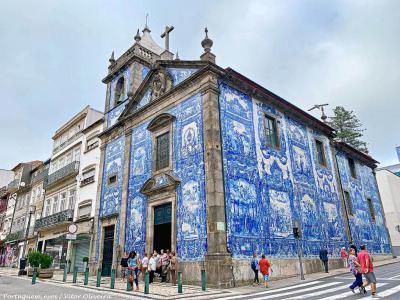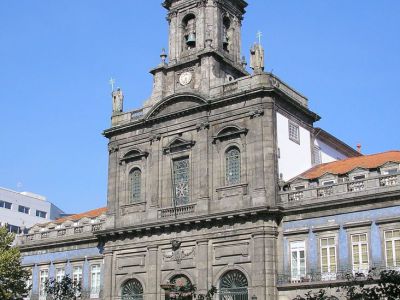Historical Churches (Self Guided), Porto
Portugal is one of the oldest countries in Europe and is deeply rooted in Christianity, notably Catholicism. The latter explains the abundance of historic chapels, churches, and monasteries in the country. Porto, a city with a rich historical and cultural heritage, boasts several old churches of its own. Remarkable architectural gems, they reflect the city's profound religious tradition.
Among the notable local landmarks is the Carmo Church (Igreja do Carmo), combining two structures from the 1600s and 1700s. Its striking exterior clad in blue tiles narrates the history of the Carmelite order.
A few blocks away from it stands the Chapel of São José das Taipas, a testament to the city's devoutness, featuring a modest yet elegant design.
Another significant sight to behold is the Church of Mercy (Igreja da Misericórdia), known for its Baroque style and on-site museum.
The Church and Tower of the Clergymen, an enduring symbol of Porto, is the work of an 18th-century Italian architect, who left a significant mark on the city with this iconic project.
Likewise, the Saint Anthony Church of the Gatherers captures the imagination with its elegant Baroque facade richly adorned with fabulous tile work.
In turn, the Santa Clara Church exudes a sense of reverence and enchants visitors with its lavish interior, featuring elaborate wood carvings gilded in real gold and a stunning portico.
While the Church of Santo Ildefonso stands out with its distinctive twin bell towers, the Chapel of Souls (Capela das Almas) captivates passers-by with its mesmerizing azulejo panels depicting scenes from the lives of saints.
Lastly, the Trinidad Church (Igreja da Trinidade), with its imposing facade and grandeur, invites visitors to marvel at its architectural splendor.
These historical places of worship are repositories of Porto's cultural heritage, preserving centuries of tradition and craftsmanship. As you explore these sacred sites, regardless of whether you're a devout pilgrim or a curious traveler, take a moment to reflect on the city's enduring legacy of faith and artistry. This way, you may get a glimpse into Porto's soul and experience its spiritual and cultural richness firsthand.
Among the notable local landmarks is the Carmo Church (Igreja do Carmo), combining two structures from the 1600s and 1700s. Its striking exterior clad in blue tiles narrates the history of the Carmelite order.
A few blocks away from it stands the Chapel of São José das Taipas, a testament to the city's devoutness, featuring a modest yet elegant design.
Another significant sight to behold is the Church of Mercy (Igreja da Misericórdia), known for its Baroque style and on-site museum.
The Church and Tower of the Clergymen, an enduring symbol of Porto, is the work of an 18th-century Italian architect, who left a significant mark on the city with this iconic project.
Likewise, the Saint Anthony Church of the Gatherers captures the imagination with its elegant Baroque facade richly adorned with fabulous tile work.
In turn, the Santa Clara Church exudes a sense of reverence and enchants visitors with its lavish interior, featuring elaborate wood carvings gilded in real gold and a stunning portico.
While the Church of Santo Ildefonso stands out with its distinctive twin bell towers, the Chapel of Souls (Capela das Almas) captivates passers-by with its mesmerizing azulejo panels depicting scenes from the lives of saints.
Lastly, the Trinidad Church (Igreja da Trinidade), with its imposing facade and grandeur, invites visitors to marvel at its architectural splendor.
These historical places of worship are repositories of Porto's cultural heritage, preserving centuries of tradition and craftsmanship. As you explore these sacred sites, regardless of whether you're a devout pilgrim or a curious traveler, take a moment to reflect on the city's enduring legacy of faith and artistry. This way, you may get a glimpse into Porto's soul and experience its spiritual and cultural richness firsthand.
How it works: Download the app "GPSmyCity: Walks in 1K+ Cities" from Apple App Store or Google Play Store to your mobile phone or tablet. The app turns your mobile device into a personal tour guide and its built-in GPS navigation functions guide you from one tour stop to next. The app works offline, so no data plan is needed when traveling abroad.
Historical Churches Map
Guide Name: Historical Churches
Guide Location: Portugal » Porto (See other walking tours in Porto)
Guide Type: Self-guided Walking Tour (Sightseeing)
# of Attractions: 9
Tour Duration: 2 Hour(s)
Travel Distance: 3.9 Km or 2.4 Miles
Author: ChristineS
Sight(s) Featured in This Guide:
Guide Location: Portugal » Porto (See other walking tours in Porto)
Guide Type: Self-guided Walking Tour (Sightseeing)
# of Attractions: 9
Tour Duration: 2 Hour(s)
Travel Distance: 3.9 Km or 2.4 Miles
Author: ChristineS
Sight(s) Featured in This Guide:
- Igreja do Carmo (Carmo Church)
- Capela de São José das Taipas (São José das Taipas Chapel)
- Igreja da Misericórdia (Church of Mercy)
- Church and Tower of the Clergymen
- Saint Anthony Church of the Gatherers
- Igreja de Santa Clara (St. Clara Church)
- Santo Ildefonso Church
- Capela das Almas (Chapel of Souls)
- Igreja da Trinidade (Trinity Church)
1) Igreja do Carmo (Carmo Church)
One of the oldest buildings in the historic part of Porto, Igreja do Carmo is actually a combination of two buildings: one dating from the 1600s and the other from the 1700s. Originally, it was built for the Carmelite order of the Roman Catholic Church and was used as a convent. The Baroque style structure features golden woodwork in the interior along with neoclassical tiles. It has a classic façade with a bell tower. The oldest of the two parts of the church – built with a single nave – has seven altars created by Francisco Pereira Campanhã.
The exterior wall of the building is covered in tiles depicting the history of the Carmelite order. Connecting the right and the left side of the structure is a narrow building which measures only one meter in width and was meant originally to keep the monks separated from the nuns of the convent, thus preserving the nuns' chastity and helping the monks keep their vows of celibacy.
Why You Should Visit:
Stunning inside and out; a glorious example of Porto's traditional 'azulejos' (tiles), which are often blue and white and have been handpainted.
The organ is a piece of art and highly unusual, in that there are horizontal horns protruding from the pipe area.
Tip:
Be sure to visit the 1-meter wide house separating the two churches – one of the world's narrowest buildings.
The exterior wall of the building is covered in tiles depicting the history of the Carmelite order. Connecting the right and the left side of the structure is a narrow building which measures only one meter in width and was meant originally to keep the monks separated from the nuns of the convent, thus preserving the nuns' chastity and helping the monks keep their vows of celibacy.
Why You Should Visit:
Stunning inside and out; a glorious example of Porto's traditional 'azulejos' (tiles), which are often blue and white and have been handpainted.
The organ is a piece of art and highly unusual, in that there are horizontal horns protruding from the pipe area.
Tip:
Be sure to visit the 1-meter wide house separating the two churches – one of the world's narrowest buildings.
2) Capela de São José das Taipas (São José das Taipas Chapel)
Chapel of São José das Taipas, located in Porto, is a remarkable Neoclassical church whose construction spanned over eight decades, from 1795 to 1878. Designed by the architect Carlos Cruz Amarante, the church’s prolonged completion was influenced by various social and political disruptions in the early 19th century.
The church's facade is modest, featuring a low bell tower adorned with tiles, embodying a restrained architectural style. Inside, the church consists of a nave bordered by a balcony with iron railings and features a series of gilded altars. Behind the main altar, there are four side altars dedicated to health, conception, Our Lady of Sorrows, and Saint Anthony.
The chapel and some of its interiors predate the church, dating back to 1666. Among its historical treasures, the church houses Porto's oldest Nativity Scene, from the 18th century and attributed to the School of Machado de Castro. Additionally, it displays a significant painting from 1845 depicting the Barcas Bridge disaster, an event that deeply affected the city during the French invasion of 1809. The Brotherhood of Almas de São José das Taipas, to which the church belongs, traditionally prayed for the souls lost in this tragic event.
A valuable painting of the German School, representing Our Lady of Divine Providence (Nossa Senhora da Divina Providência), further enhances the church’s artistic heritage. Visitors can also explore the museum and catacombs located beneath the chancel, with information available in Portuguese, Spanish, and English. This parish church, nestled in Porto’s historic center, remains a testament to the city's rich cultural and religious history.
The church's facade is modest, featuring a low bell tower adorned with tiles, embodying a restrained architectural style. Inside, the church consists of a nave bordered by a balcony with iron railings and features a series of gilded altars. Behind the main altar, there are four side altars dedicated to health, conception, Our Lady of Sorrows, and Saint Anthony.
The chapel and some of its interiors predate the church, dating back to 1666. Among its historical treasures, the church houses Porto's oldest Nativity Scene, from the 18th century and attributed to the School of Machado de Castro. Additionally, it displays a significant painting from 1845 depicting the Barcas Bridge disaster, an event that deeply affected the city during the French invasion of 1809. The Brotherhood of Almas de São José das Taipas, to which the church belongs, traditionally prayed for the souls lost in this tragic event.
A valuable painting of the German School, representing Our Lady of Divine Providence (Nossa Senhora da Divina Providência), further enhances the church’s artistic heritage. Visitors can also explore the museum and catacombs located beneath the chancel, with information available in Portuguese, Spanish, and English. This parish church, nestled in Porto’s historic center, remains a testament to the city's rich cultural and religious history.
3) Igreja da Misericórdia (Church of Mercy)
Church of Mercy is a fantastic church that can be found in the center of Porto on the Rua das Flores. It is a very popular attraction with visitors to the metropolis. The structure has a history which begins in the 1500s. Although the building has gone through several renovations over the years, there are still many of the original elements. The façade is reminiscent of the Baroque style of architecture and was added in the 1700s.
Visitors will enjoy exploring the museum inside the building which exhibits many 15th century artworks and artifacts. One, in particular, is the Flemish Fins Vitae that shows King Manuel I and his wife, Leonor, kneeling before the crucifixion. King Manuel I was a 14th-century ruler, under whose reign Portugal became a world power.
The street – Rua das Flores (Flowers Street) – where the structure is located has a history dating back to 1521. It is lined with beautiful homes with wrought iron balconies and iconic embellishments. For those who are fascinated with architecture and design, this street will be well worth setting aside some time to explore.
Tip:
This stunning church is open for only a few hours a day, but you can get to see it as part of your entry to the adjacent museum (10am-6:30pm) that boasts a collection of sacred art.
Visitors will enjoy exploring the museum inside the building which exhibits many 15th century artworks and artifacts. One, in particular, is the Flemish Fins Vitae that shows King Manuel I and his wife, Leonor, kneeling before the crucifixion. King Manuel I was a 14th-century ruler, under whose reign Portugal became a world power.
The street – Rua das Flores (Flowers Street) – where the structure is located has a history dating back to 1521. It is lined with beautiful homes with wrought iron balconies and iconic embellishments. For those who are fascinated with architecture and design, this street will be well worth setting aside some time to explore.
Tip:
This stunning church is open for only a few hours a day, but you can get to see it as part of your entry to the adjacent museum (10am-6:30pm) that boasts a collection of sacred art.
4) Church and Tower of the Clergymen (must see)
Nicolau Nasoni, an Italian architect and painter of the 18th century, did a lot of work throughout Portugal. His most memorable project is the Church and Tower of the Clergymen. His other works include the construction of the Misericordia Church, the Archbishop's Palace and the lateral loggia of Porto Cathedral.
Construction of the church was completed in 1750. The bell tower and divided staircase in front of the church were not finished until 1763. The facade is ornate with Baroque decorations such as garlands and shells and an indented pediment. The frieze above the windows has spiritual symbols. The sides show an elliptical nave.
The Church of the Clergymen (Clerigos) was among the first baroque style churches to have an elliptical floorplan. The polychromed marble altarpiece in the large chapel was done by Manuel dos Santos Porto.
The Tower is in a Roman Baroque style of Tuscan bell towers. It is 245 feet high and it takes 240 steps to reach the top for an incredible view of Porto. The tower is one of the recognizable symbols of Porto.
Nicolau entered the Clerigos Brotherhood and when he died he was buried in the crypt of his masterpiece, The Church and Tower of the Clergymen.
Construction of the church was completed in 1750. The bell tower and divided staircase in front of the church were not finished until 1763. The facade is ornate with Baroque decorations such as garlands and shells and an indented pediment. The frieze above the windows has spiritual symbols. The sides show an elliptical nave.
The Church of the Clergymen (Clerigos) was among the first baroque style churches to have an elliptical floorplan. The polychromed marble altarpiece in the large chapel was done by Manuel dos Santos Porto.
The Tower is in a Roman Baroque style of Tuscan bell towers. It is 245 feet high and it takes 240 steps to reach the top for an incredible view of Porto. The tower is one of the recognizable symbols of Porto.
Nicolau entered the Clerigos Brotherhood and when he died he was buried in the crypt of his masterpiece, The Church and Tower of the Clergymen.
5) Saint Anthony Church of the Gatherers
Located in Porto, Portugal, the Igreja de Santo Antonio Congregados, also known as the Saint Anthony Church of the Gatherers, is dedicated to Saint Anthony of Padua. This Portuguese born saint, Saint Anthony was born in the 12th century and became a Franciscan priest. The Franciscans were the largest member of the Order of the Friars Minor and were founded by Saint Francis Assisi. As a missionary, he eventually found his calling in Padua, Italy.
The building was constructed during the late part of the 17th century. The church replaced the original church which stood on this land for several hundred years. Designed by the very popular and world renowned architect of the time, Joaquim Jaime B. Ferreira-Alves, it is elegant and elaborate with Baroque features including the fabulous tile work which was created by the famed artisans, Jorge Colaço and João Baptista Ribeiro.
The tile work tells the story of Saint Anthony and the Assumption of the Blessed Virgin Mary. Baroque style is characterized by sharp details and larger-than-life motion which, it its architectural constructions often appear as if they are seamlessly reaching for the sky. Many of the Roman Catholic Churches throughout Europe have some style elements of the Baroque period of art and architecture.
The building was constructed during the late part of the 17th century. The church replaced the original church which stood on this land for several hundred years. Designed by the very popular and world renowned architect of the time, Joaquim Jaime B. Ferreira-Alves, it is elegant and elaborate with Baroque features including the fabulous tile work which was created by the famed artisans, Jorge Colaço and João Baptista Ribeiro.
The tile work tells the story of Saint Anthony and the Assumption of the Blessed Virgin Mary. Baroque style is characterized by sharp details and larger-than-life motion which, it its architectural constructions often appear as if they are seamlessly reaching for the sky. Many of the Roman Catholic Churches throughout Europe have some style elements of the Baroque period of art and architecture.
6) Igreja de Santa Clara (St. Clara Church)
Santa Clara's structure dates back to the 1400s and is an excellent example of Baroque architecture. The building was constructed for the Roman Catholic Church. The interior holds a vast selection of some of the best gilded Baroque woodwork in all of Porto. Originally it housed both a monastery and convent and continued to be used in this fashion until the 19th century.
The entrance of the structure has a large Baroque door which is flanked by Renaissance characteristics, including Solomonic columns with Corinthian capitals. These were added during one of the several renovations which took place over its lifetime. Solomonic columns typically can be described as having a twisted corkscrew shape which cannot be mistaken with other column designs. Corinthian capitals are usually seen embellished with scrolls and acanthus leaves.
The interior of the church is definitely the place a guest to the city who is fascinated with elaborate décor will want to explore. The interior of this facility has elaborate wood carvings throughout it with many of them gilded in real gold. The portico, which was created by famed artist, Miguel Francisco da Silva, is something special to admire.
Tip:
You should expedite your visit as they should close soon (5/2019) for 2 to 3 years of rehabilitation works.
The entrance of the structure has a large Baroque door which is flanked by Renaissance characteristics, including Solomonic columns with Corinthian capitals. These were added during one of the several renovations which took place over its lifetime. Solomonic columns typically can be described as having a twisted corkscrew shape which cannot be mistaken with other column designs. Corinthian capitals are usually seen embellished with scrolls and acanthus leaves.
The interior of the church is definitely the place a guest to the city who is fascinated with elaborate décor will want to explore. The interior of this facility has elaborate wood carvings throughout it with many of them gilded in real gold. The portico, which was created by famed artist, Miguel Francisco da Silva, is something special to admire.
Tip:
You should expedite your visit as they should close soon (5/2019) for 2 to 3 years of rehabilitation works.
7) Santo Ildefonso Church
The Church of Saint Ildefonso (Igreja de Santo Ildefonso) is a prominent eighteenth-century church located near Batalha Square in Porto. Completed in 1739, this proto-Baroque church is a testament to the artistic and architectural heritage of Porto. Named in honor of Ildephonsus of Toledo, a Visigothic bishop from the 7th century, the church replaced an earlier chapel, Santo Alifon, which was mentioned as early as 1296 and was in a state of disrepair by the early 18th century. The original chapel was demolished in 1709, and construction of the current church began the same year, spanning three decades.
The architect of the Church of Saint Ildefonso is unknown, but records list craftsmen like carpenters, masons, and a locksmith. The first construction phase ended in 1730 with the completion of the main body and tympanum. From 1730 to 1739, the bell towers, façade, and narthex were added. The façade, made of plain granite with cornices, dentils, spheres, a stone cross, and metalwork flags, features about 11,000 Azulejo tiles by Jorge Colaço from 1932, depicting scenes from Saint Ildefonso’s life and the Gospels.
The church has undergone various restorations and modifications over the years. After suffering damage from a severe storm in 1819 and artillery fire during the Siege of Porto in 1833, it was extensively repaired. Further enhancements included the installation of new stained glass windows by artist Isolino Vaz in 1967 and renovations in 1996 that led to the discovery of nineteen graves in the narthex, corresponding to the original chapel's churchyard.
Constructed of granite in an elongated octagon shape, the church features decorative plaster ceilings and a notable retable designed by the Italian artist Nicolau Nasoni, installed in 1745. Despite the extensive repairs and alterations, the Church of Saint Ildefonso retains much of its original charm and continues to be a significant historical and cultural landmark in Porto, drawing visitors and worshippers alike with its daily masses and striking architectural presence.
The architect of the Church of Saint Ildefonso is unknown, but records list craftsmen like carpenters, masons, and a locksmith. The first construction phase ended in 1730 with the completion of the main body and tympanum. From 1730 to 1739, the bell towers, façade, and narthex were added. The façade, made of plain granite with cornices, dentils, spheres, a stone cross, and metalwork flags, features about 11,000 Azulejo tiles by Jorge Colaço from 1932, depicting scenes from Saint Ildefonso’s life and the Gospels.
The church has undergone various restorations and modifications over the years. After suffering damage from a severe storm in 1819 and artillery fire during the Siege of Porto in 1833, it was extensively repaired. Further enhancements included the installation of new stained glass windows by artist Isolino Vaz in 1967 and renovations in 1996 that led to the discovery of nineteen graves in the narthex, corresponding to the original chapel's churchyard.
Constructed of granite in an elongated octagon shape, the church features decorative plaster ceilings and a notable retable designed by the Italian artist Nicolau Nasoni, installed in 1745. Despite the extensive repairs and alterations, the Church of Saint Ildefonso retains much of its original charm and continues to be a significant historical and cultural landmark in Porto, drawing visitors and worshippers alike with its daily masses and striking architectural presence.
8) Capela das Almas (Chapel of Souls) (must see)
At the end of the eighteenth century the Brotherhood of Souls moved from the Monastery of Santa Clara to the chapel of Santa Catarina. The addition of the Brotherhood swelled the size of the Santa Catarina faction of devotees to the point where a new building was needed. The chapel therefore was expanded and restored in 1801.
The facade has a framed door under a circular pediment. A coat of arms is set on the tympanum showing Saint Francis of Assisi and Santa Catarina. The bell tower has two floors. On the first floor is a door with a window. The second floor has four windows and a balcony. Atop the dome is an iron cross.
The style of the church is basically neoclassical, but the church is noted for its covering of azulejo tiles. The tiles were made at the Viuva Lamego Ceramic Workshop in Lisbon. The 16,000 glowing blue and white tiles depict scenes from the lives of Saint Catherine and Saint Francis of Assisi.
The stained glass windows, made by Amandio Silva, show the souls in Purgatory washed with the redeeming blood of Christ. Inside the chapel is the 18th century image, Virgin of Souls. On the main altar is the large painting called "The Ascension of the Lord" by Joaquin Rafael, a professor of Fine Arts in Lisbon.
This is without a doubt, the most beautiful church in Porto. It must not be overlooked.
The facade has a framed door under a circular pediment. A coat of arms is set on the tympanum showing Saint Francis of Assisi and Santa Catarina. The bell tower has two floors. On the first floor is a door with a window. The second floor has four windows and a balcony. Atop the dome is an iron cross.
The style of the church is basically neoclassical, but the church is noted for its covering of azulejo tiles. The tiles were made at the Viuva Lamego Ceramic Workshop in Lisbon. The 16,000 glowing blue and white tiles depict scenes from the lives of Saint Catherine and Saint Francis of Assisi.
The stained glass windows, made by Amandio Silva, show the souls in Purgatory washed with the redeeming blood of Christ. Inside the chapel is the 18th century image, Virgin of Souls. On the main altar is the large painting called "The Ascension of the Lord" by Joaquin Rafael, a professor of Fine Arts in Lisbon.
This is without a doubt, the most beautiful church in Porto. It must not be overlooked.
9) Igreja da Trinidade (Trinity Church)
The Trinity Church (Igreja da Trindade) is a prominent Neoclassical church located in Trinity Square (Praça da Trindade), behind Porto's City Hall, and is an essential landmark in Porto. This imposing structure, which occupies an entire city block, was designed by architect and military engineer Carlos Amarante in the early 19th century, although some alterations may have been made by José Francisco in 1818. The church's construction began in the first half of the 19th century and was completed in the early 20th century, with the church officially opening its doors for worship on June 5, 1841.
Built as part of a complex associated with the hospital of the Third Order of the Holy Trinity, established in 1755 after the suppression of the Order of Saint Dominic, the Church of the Trinity reflects Neoclassical architecture with touches of the Baroque tradition. The interior is known for its technical craftsmanship, including intricate marble work and elaborately carved and gilded wood altarpieces, most notably the high altar created by architect José Marques da Silva. A standout feature in the chancel is a large painting by José de Brito, depicting the Baptism of Christ.
Legend has it that the church is a site of divine vision, where the seer and thaumaturge Wilhelmina reportedly experienced a vision of the Holy Trinity accompanied by angels singing the Tantum Ergo Sacramentum. This same seer also had visions of Our Lady in Vergada, Argoncilhe. Architect Carlos Amarante, who was instrumental in the church’s design, is buried within its walls, further cementing his lasting legacy in this significant piece of Porto's architectural and spiritual heritage.
Built as part of a complex associated with the hospital of the Third Order of the Holy Trinity, established in 1755 after the suppression of the Order of Saint Dominic, the Church of the Trinity reflects Neoclassical architecture with touches of the Baroque tradition. The interior is known for its technical craftsmanship, including intricate marble work and elaborately carved and gilded wood altarpieces, most notably the high altar created by architect José Marques da Silva. A standout feature in the chancel is a large painting by José de Brito, depicting the Baptism of Christ.
Legend has it that the church is a site of divine vision, where the seer and thaumaturge Wilhelmina reportedly experienced a vision of the Holy Trinity accompanied by angels singing the Tantum Ergo Sacramentum. This same seer also had visions of Our Lady in Vergada, Argoncilhe. Architect Carlos Amarante, who was instrumental in the church’s design, is buried within its walls, further cementing his lasting legacy in this significant piece of Porto's architectural and spiritual heritage.
Walking Tours in Porto, Portugal
Create Your Own Walk in Porto
Creating your own self-guided walk in Porto is easy and fun. Choose the city attractions that you want to see and a walk route map will be created just for you. You can even set your hotel as the start point of the walk.
Porto Historic Center Walking Tour
The Historic Centre of Porto, dating back to the Medieval times, is the oldest part of the city and a UNESCO World Heritage Site since 1996. Despite all the changes over the years, it has maintained the unique urban characteristics, which are a world apart from other European cities, and preserved much of its legacy from the times gone by.
Firmly set on the hillsides overlooking the mouth of... view more
Tour Duration: 2 Hour(s)
Travel Distance: 2.6 Km or 1.6 Miles
Firmly set on the hillsides overlooking the mouth of... view more
Tour Duration: 2 Hour(s)
Travel Distance: 2.6 Km or 1.6 Miles
Porto Introduction Walking Tour
After 711 Porto fell to Moorish invaders. The Muslim control existed in the Iberian peninsula until 1491. However, the conquest was not total and in 868 things began to change for the people of Porto.
Vimara Peres, an Asturian count of Gallaecia, came to reconquer for the Christians. He secured the town of Portu Cale and the land of Vila Nova de Gaia. Vimara became the Count of Portucale. From... view more
Tour Duration: 2 Hour(s)
Travel Distance: 3.2 Km or 2 Miles
Vimara Peres, an Asturian count of Gallaecia, came to reconquer for the Christians. He secured the town of Portu Cale and the land of Vila Nova de Gaia. Vimara became the Count of Portucale. From... view more
Tour Duration: 2 Hour(s)
Travel Distance: 3.2 Km or 2 Miles
Shopping and Food Tour
Renowned for its centuries-old culture and architecture, Porto also boasts a wealth of shopping and dining opportunities. With a mix of the modern and historical, the city represents a fertile ground for bargain hunters, foodies and luxury-seekers alike.
Those on the look-out for trendy clothing and accessories, or wanting to sample some delicious local cuisine, will certainly not be... view more
Tour Duration: 1 Hour(s)
Travel Distance: 1.6 Km or 1 Miles
Those on the look-out for trendy clothing and accessories, or wanting to sample some delicious local cuisine, will certainly not be... view more
Tour Duration: 1 Hour(s)
Travel Distance: 1.6 Km or 1 Miles
Porto's Monuments and Statues
In general, just like any other European nation, sunny Portugal is rich in history and matching love of monuments. This is more so evident in the country's second largest city of Porto, dotted with statues and sculptures of various sort, decorating the gardens, sidewalks, squares and various corners. Each of them has its own story; some are quite old, while others are not so much and rather... view more
Tour Duration: 1 Hour(s)
Travel Distance: 2.1 Km or 1.3 Miles
Tour Duration: 1 Hour(s)
Travel Distance: 2.1 Km or 1.3 Miles
The Most Popular Cities
/ view all
